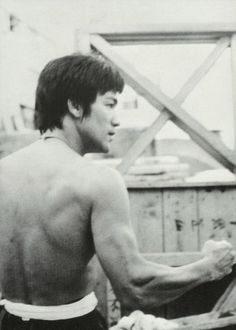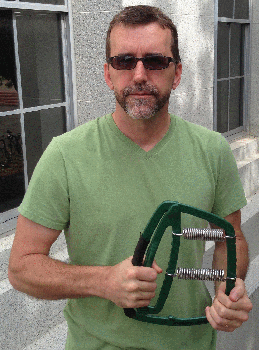
Grip and Wrist Training
March 05, 2015
“There are no wrists in boxing…The forearm and the fist should be used as one solid piece, like a club with a knot on the end of it. The fist should be kept on a straight line with the forearm and there should be no bending of the wrist in any direction.
Bruce Lee in Tao of Jeet Kune Do
If you start conditioning your hands using a wall bag or a heavy bag, you’ll quickly discover the weak link in striking.
 Its in the wrists.
Its in the wrists.
Strikers should pay a lot of attention to strengthening their grip and their wrists.
Developing your striking power has many parts. You must learn to use the ground. You must learn to use your structure. You must relax. You must move in a coordinated fashion (Sam Yi Hap Yat).
As your capacity to deliver force increases, you will probably reach the point where you discover your wrists have a dangerous tendency to buckle. This is especially likely to occur when training on a heavy bag or a “banana” bag. These bags swing and move and will reveal what happens when you strike a target with your wrist in a less than perfectly aligned position.
The wrists and the grip also come into play in actions like the Lap Sau, the Toi Sau, and the various pulls.
Having supple but strong wrists and a powerful grip will amp up your game in many ways.
Bruce Lee was notoriously finicky about developing this part of his body, as you can see from these photos.
You can see it with boxers and MMA types also. This is one of the things developed by hitting a big tire with a sledgehammer. Old time boxers like Gene Tunney and Dempsey used to chop wood.
There are lots of ways to develop this attribute, from large equipment like the one Bruce is using here (you squeeze and the gap is narrowed,
 thus lifting those weights) to just squeezing a rubber ball (using basically dynamic tension).
thus lifting those weights) to just squeezing a rubber ball (using basically dynamic tension).
One of things used by weight lifters (who want to either supplement or do without wrist straps) is a thick bar, which is a heavy bar with a circumference another half or twice as thick as the usual Olympic bar. This is picked and the training is a static hold.
Other methods people use include various static holds such as a “pinch grip” where you pinch two Olympic plates together and hold them in place. Others do something similar by holding a couple of very heavy dumbbells and just stand there holding them (or walk with them, which they call a Farmer’s walk). Be careful!
Another Bruce Lee favorite was the fingertips push up or push ups on the knuckles. Personally I don’t think knuckle push ups are good for you (part of what you are resting your weight on are small delicate tendons necessary for fine motor skills like typing and holding a pen).
I do fingertip push ups once in a blue moon but generally I have one particular exercise for the wrist and a few for the grip.
 My favorite wrist exercise is using the heavy Baat Jaam Do (see my instruction for building these and training with them
HERE
), especially the one at the front of the form where you are tapping forward (sort of the reverse of the sun fist extension).
My favorite wrist exercise is using the heavy Baat Jaam Do (see my instruction for building these and training with them
HERE
), especially the one at the front of the form where you are tapping forward (sort of the reverse of the sun fist extension).
I also do a lot of pull ups in my office, which trains all sorts of muscles but especially the grip, since I have to keep 175 pounds from falling off.
For my grip, I use the Ivanko Gripper, which is a heavy-duty bit of equipment I bought back in 2001. What I like about the Ivanko Gripper is it has progressive settings, so as I get stronger, I can increase the load. You can also up the setting to a tension too difficult to close with one hand, then hold that with a static hold or slowly let it release (like a negative repetition).
Currently I’m squeezing about 120 LBS of force, which isn’t bad (although it goes up to 345!).
The strong men of the old days used to perform feats of grip strength like bending pennies and railroad spikes and tearing phone books in half!
Be careful with this stuff – err on the side of caution. It becomes really hard to type after blowing out your hands with exercise.